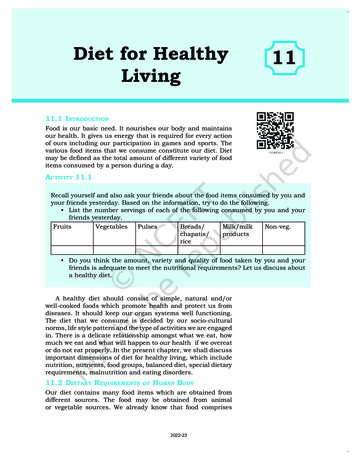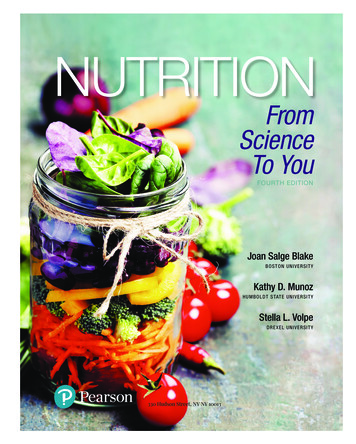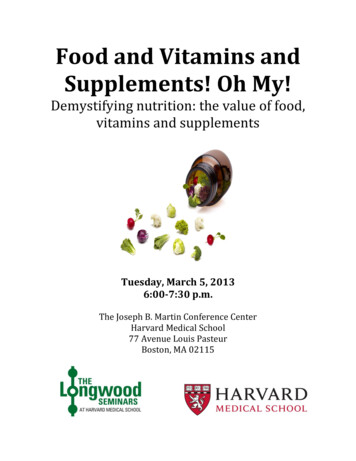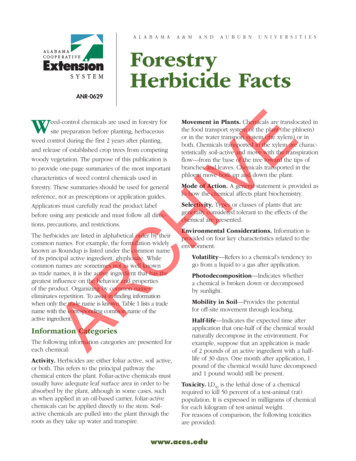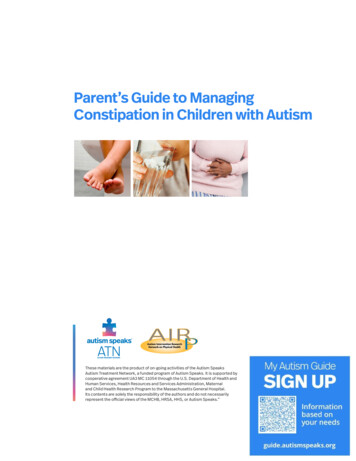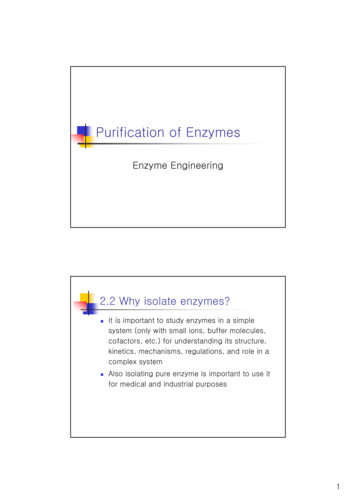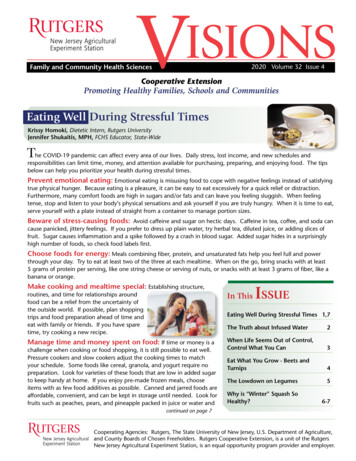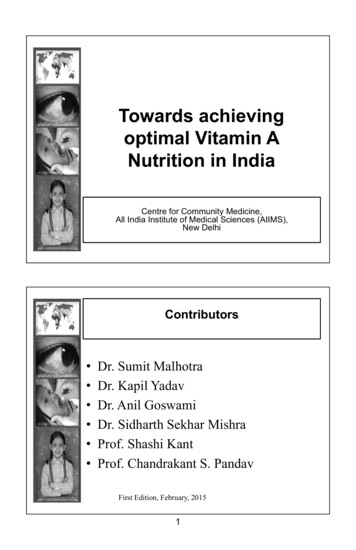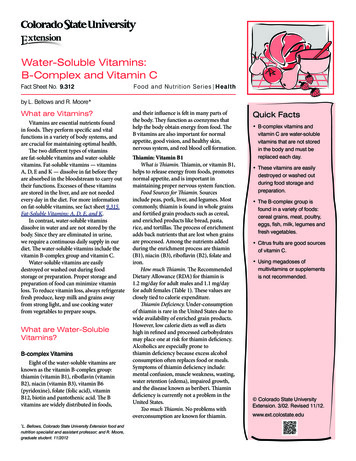
Transcription
Water-Soluble Vitamins:B-Complex and Vitamin CFact Sheet No. 9.312Food and Nutrition Series Healthby L. Bellows and R. Moore*What are Vitamins?Vitamins are essential nutrients foundin foods. They perform specific and vitalfunctions in a variety of body systems, andare crucial for maintaining optimal health.The two different types of vitaminsare fat-soluble vitamins and water-solublevitamins. Fat-soluble vitamins — vitaminsA, D, E and K — dissolve in fat before theyare absorbed in the bloodstream to carry outtheir functions. Excesses of these vitaminsare stored in the liver, and are not neededevery day in the diet. For more informationon fat-soluble vitamins, see fact sheet 9.315Fat-Soluble Vitamins: A, D, E, and K.In contrast, water-soluble vitaminsdissolve in water and are not stored by thebody. Since they are eliminated in urine,we require a continuous daily supply in ourdiet. The water-soluble vitamins include thevitamin B-complex group and vitamin C.Water-soluble vitamins are easilydestroyed or washed out during foodstorage or preparation. Proper storage andpreparation of food can minimize vitaminloss. To reduce vitamin loss, always refrigeratefresh produce, keep milk and grains awayfrom strong light, and use cooking waterfrom vegetables to prepare soups.What are Water-SolubleVitamins?B-complex VitaminsEight of the water-soluble vitamins areknown as the vitamin B-complex group:thiamin (vitamin B1), riboflavin (vitaminB2), niacin (vitamin B3), vitamin B6(pyridoxine), folate (folic acid), vitaminB12, biotin and pantothenic acid. The Bvitamins are widely distributed in foods,L. Bellows, Colorado State University Extension food andnutrition specialist and assistant professor; and R. Moore,graduate student. 11/2012*and their influence is felt in many parts ofthe body. They function as coenzymes thathelp the body obtain energy from food. TheB vitamins are also important for normalappetite, good vision, and healthy skin,nervous system, and red blood cell formation.Thiamin: Vitamin B1What is Thiamin. Thiamin, or vitamin B1,helps to release energy from foods, promotesnormal appetite, and is important inmaintaining proper nervous system function.Food Sources for Thiamin. Sourcesinclude peas, pork, liver, and legumes. Mostcommonly, thiamin is found in whole grainsand fortified grain products such as cereal,and enriched products like bread, pasta,rice, and tortillas. The process of enrichmentadds back nutrients that are lost when grainsare processed. Among the nutrients addedduring the enrichment process are thiamin(B1), niacin (B3), riboflavin (B2), folate andiron.How much Thiamin. The RecommendedDietary Allowance (RDA) for thiamin is1.2 mg/day for adult males and 1.1 mg/dayfor adult females (Table 1). These values areclosely tied to calorie expenditure.Thiamin Deficiency. Under-consumptionof thiamin is rare in the United States due towide availability of enriched grain products.However, low calorie diets as well as dietshigh in refined and processed carbohydratesmay place one at risk for thiamin deficiency.Alcoholics are especially prone tothiamin deficiency because excess alcoholconsumption often replaces food or meals.Symptoms of thiamin deficiency include:mental confusion, muscle weakness, wasting,water retention (edema), impaired growth,and the disease known as beriberi. Thiamindeficiency is currently not a problem in theUnited States.Too much Thiamin. No problems withoverconsumption are known for thiamin.Quick Facts B-complex vitamins andvitamin C are water-solublevitamins that are not storedin the body and must bereplaced each day. These vitamins are easilydestroyed or washed outduring food storage andpreparation. The B-complex group isfound in a variety of foods:cereal grains, meat, poultry,eggs, fish, milk, legumes andfresh vegetables. Citrus fruits are good sourcesof vitamin C. Using megadoses ofmultivitamins or supplementsis not recommended. Colorado State UniversityExtension. 3/02. Revised 11/12.www.ext.colostate.edu
Riboflavin: Vitamin B2What is Riboflavin. Riboflavin, orvitamin B2, helps to release energy fromfoods, promotes good vision, and healthyskin. It also helps to convert the amino acidtryptophan (which makes up protein) intoniacin.Food Sources for Riboflavin. Sourcesinclude liver, eggs, dark green vegetables,legumes, whole and enriched grainproducts, and milk. Ultraviolet light isknown to destroy riboflavin, which is whymost milk is packaged in opaque containersinstead of clear.How much Riboflavin. TheRecommended Dietary Allowance (RDA)for riboflavin is 1.3 mg/day for adult malesand 1.1 mg/day for adult females (Table 1).Like thiamin, these values are closely tied toenergy expenditure.Riboflavin Deficiency. Underconsumption of riboflavin is rare in theUnited States. However, it has been knownto occur with alcoholism, malignancy,hyperthyroidism, and in the elderly.Symptoms of deficiency include cracks atthe corners of the mouth, dermatitis onnose and lips, light sensitivity, cataracts, anda sore, red tongue.Too much Riboflavin. No problems withoverconsumption are known for riboflavin.Niacin: Vitamin B3, Nicotinamide,Nicotinic Acid.What is Niacin. Niacin, or vitamin B3,is involved in energy production, normalenzyme function, digestion, promotingnormal appetite, healthy skin, and nerves.Food Sources for Niacin. Sources includeliver, fish, poultry, meat, peanuts, whole andenriched grain products.How much Niacin. The RecommendedDietary Allowance (RDA) for niacin is16 mg/day for adult males and 14 mg/dayfor adult females (Table 1). These values areclosely tied to energy expenditure.Niacin Deficiency. Niacin deficiencyis not a problem in the United States.However, it is known to occur withalcoholism, protein malnourishment, lowcalorie diets, and diets high in refinedcarbohydrates. Pellagra is the disease statethat occurs as a result of severe niacindeficiency. Symptoms include cramps,nausea, mental confusion, and skinproblems.Too much Niacin. Consuming largedoses of niacin supplements may causeflushed skin, rashes, or liver damage(Table 2). Over consumption of niacin isnot a problem if it is obtained through food.Vitamin B6: Pyridoxine, Pyridoxal,PyridoxamineWhat is Vitamin B6. Vitamin B6,otherwise known as pyridoxine, pyridoxalor pyridoxamine, aids in proteinmetabolism and red blood cell formation. Itis also involved in the body’s production ofchemicals such as insulin and hemoglobin.Food Sources for Vitamin B6. Sourcesinclude pork, meats, whole grainsand cereals, legumes, and green, leafyvegetables.How much Vitamin B6. TheRecommended Dietary Allowance (RDA)for vitamin B6 is 1.3 mg/day for adult malesand females through age fifty (Table 1).For infants, breast milk and most infantformulas contain enough vitamin B6.Vitamin B6 Deficiency. Deficiencysymptoms include skin disorders,dermatitis, cracks at corners of mouth,anemia, kidney stones, and nausea. Avitamin B6 deficiency in infants can causemental confusion.Too much Vitamin B6. Overconsumption is rare, but excess doses ofvitamin B6 over time have been known toresult in nerve damage (Table 2).Folate: Folic Acid, FolacinWhat is Folate. Folate, also knownas folic acid or folacin, aids in proteinmetabolism, promoting red blood cellformation, and lowering the risk for neuraltube birth defects. Folate may also play arole in controlling homocysteine levels,thus reducing the risk for coronary heartdisease.Food Sources for Folate. Sources offolate include liver, kidney, dark greenleafy vegetables, meats, fish, whole grains,fortified grains and cereals, legumes, andcitrus fruits. Not all whole grain productsare fortified with folate. Check the nutritionlabel to see if folic acid has been added.How much Folate. The RecommendedDietary Allowance (RDA) for folate is400 mcg/day for adult males and females.Pregnancy will increase the RDA for folateto 600 mcg/day (Table 1).Folate Deficiency. Folate deficiencyaffects cell growth and protein production,which can lead to overall impaired growth.Deficiency symptoms also include anemiaand diarrhea. A folate deficiency in womenwho are pregnant or of child bearing agemay result in the delivery of a baby withneural tube defects such as spina bifida.(Table 1).Too much Folate. Over consumption offolate offers no known benefits, and maymask B12 deficiency as well as interferewith some medications (Table 2).Vitamin B12: CobalaminWhat is B12. Vitamin B12, also knownas cobalamin, aids in the building of geneticmaterial, production of normal red bloodcells, and maintenance of the nervoussystem.Food Sources for Vitamin B12. VitaminB12 can only be found only in foods ofanimal origin such as meats, liver, kidney,fish, eggs, milk and milk products, oysters,shellfish. Some fortified foods may containvitamin B12.How much Vitamin B12. TheRecommended Dietary Allowance (RDA)for vitamin B12 is 2.4 mcg/day for adultmales and females (Table 1). For thoseover the age of fifty, the dietary guidelinesrecommend consuming vitamin B12 inits crystalline form (fortified foods ormultivitamin).Vitamin B12 Deficiency. Vitamin B12deficiency most commonly affects strictvegetarians (those who eat no animalproducts), infants of vegan mothers, andthe elderly. Symptoms of deficiency includeanemia, fatigue, neurological disorders,and degeneration of nerves resultingin numbness and tingling. In order toprevent vitamin B12 deficiency, a dietarysupplement should be taken. Some peopledevelop a B12 deficiency because theycannot absorb the vitamin through theirstomach lining. This can be treated throughvitamin B12 injections.Too much Vitamin B12. No problemswith overconsumption of vitamin B12 areknown.BiotinWhat is Biotin. Biotin helps releaseenergy from carbohydrates and aidsin the metabolism of fats, proteins andcarbohydrates from food.
Food Sources for Biotin. Sources ofBiotin include liver, kidney, egg yolk, milk,most fresh vegetables, yeast breads andcereals. Biotin is also made by intestinalbacteria.How much Biotin. The Adequate Intake(AI) for Biotin is 30 mcg/day for adultmales and females (Table 1).Biotin Deficiency. Biotin deficiency isuncommon under normal circumstances,but symptoms include fatigue, loss ofappetite, nausea, vomiting, depression,muscle pains, heart abnormalities andanemia.Too much Biotin. No problems withoverconsumption are known for Biotin.Pantothenic AcidWhat is Pantothenic Acid. PantothenicAcid is involved in energy production,and aids in the formation of hormonesand the metabolism of fats, proteins, andcarbohydrates from food.Food Sources for Pantothenic Acid.Sources include liver, kidney, meats,egg yolk, whole grains, and legumes.Pantothenic Acid is also made by intestinalbacteria.How much Pantothenic Acid. TheAdequate Intake (AI) for PantothenicAcid is 5 mg/day for both adult males andfemales (Table 1).Pantothenic Acid Deficiency.Pantothenic Acid deficiency is uncommondue to its wide availability in most foods.Too much Pantothenic Acid. Noproblems with overconsumption are knownfor Pantothenic Acid. Rarely, diarrhea andwater retention will occur with excessiveamounts.Vitamin C: Ascorbic Acid, AscorbateWhat is Vitamin CThe body needs vitamin C, also knownas ascorbic acid or ascorbate, to remainin proper working condition. Vitamin Cbenefits the body by holding cells togetherthrough collagen synthesis; collagen is aconnective tissue that holds muscles, bones,and other tissues together. Vitamin C alsoaids in wound healing, bone and toothformation, strengthening blood vesselwalls, improving immune system function,increasing absorption and utilization ofiron, and acting as an antioxidant.Since our bodies cannot produce orstore vitamin C, an adequate daily intakeof this nutrient is essential for optimumhealth. Vitamin C works with vitamin Eas an antioxidant, and plays a crucial rolein neutralizing free radicals throughoutthe body. An antioxidant can be a vitamin,mineral, or a carotenoid, present in foods,that slows the oxidation process and acts torepair damage to cells of the body. Studiessuggest that vitamin C may reduce therisk of certain cancers, heart disease, andcataracts. Research continues to documentthe degree of these effects.Food Sources for Vitamin C. Consumingvitamin C-rich foods is the best method toensure an adequate intake of this vitamin.While many common plant foods containvitamin C, the best sources are citrus fruits.For example, one orange, a kiwi fruit, 6 oz.of grapefruit juice or 1/3 cup of choppedsweet red pepper each supply enoughvitamin C for one day.How much Vitamin C. TheRecommended Dietary Allowance (RDA)for Vitamin C is 90 mg/day for adult malesand 75 mg/day for adult females (Table 1).For those who smoke cigarettes, the RDAfor vitamin C increases by 35 mg/day, inorder to counteract the oxidative effects ofnicotine.Vitamin C Deficiency. Although rarein the United States, severe vitamin Cdeficiency may result in the disease knownas scurvy, causing a loss of collagen strengththroughout the body. Loss of collagenresults in loose teeth, bleeding and swollengums, and improper wound healing. Morecommonly, vitamin C deficiency presentsas a secondary deficiency in alcoholics, theelderly, and in smokers.The following conditions have beenshown to increase vitamin C requirements(Table 1): Environmental stress, such as air andnoise pollution Use of certain drugs, such as oralcontraceptives Tissue healing of wounds Growth (children from 0- 12months, and pregnant women) Fever and infection Smoking.Too Much Vitamin C. Despite beinga water-soluble vitamin that the bodyexcretes when in excess, vitamin Coverdoses have been shown to cause kidneystones, gout, diarrhea, and rebound scurvy.Can Vitamin C Prevent the CommonCold?The controversy over using megadoses of vitamin C to prevent or cure thecommon cold and other disorders has notbeen resolved. Recent studies have shownthat an increased intake of vitamin C over500 mg per day does not increase a body’soverall level of vitamin C. Therefore, intakeover 500 mg per day may not result inany additional benefits from vitamin C(Table 2).Summary Water-soluble vitamins include thevitamin B-complex and vitamin C,and are essential nutrients neededdaily by the body in very smallquantities. The B-complex vitamins can befound in a variety of enriched foodslike cereal grains and breads, as wellas other foods such as meat, poultry,eggs, fish milk, legumes, and freshvegetables. Vitamin C can be foundin a many fruits and vegetables. Overall, in the United Statesdeficiency is rare for B vitaminsand vitamin C; with exceptions foralcoholics, those on a low caloriediet, and the elderly. Special attention should be paidto folate (folic acid) intake duringpregnancy, in order to avoid birthdefects. Vegans should be conscious ofvitamin B12 intake because it is notpresent in plant foods. Some conditions warrant anincrease in vitamin C intake, suchas exposure to cigarette smoke,environmental stress, growth, andsickness. Over consumption of the watersoluble vitamins is generally nota problem in the United States,especially if the nutrients areobtained through food. Large amounts of vitaminB-complex and vitamin Csupplements and multivitamins arenot recommended. Excesses of thesevitamins have no known benefit.
Table 1. Recommended Dietary Intake (RDA) and Adequate Intake (AI) for Water-Soluble VitaminsLife Stage GroupThiamin B1(mg/d)Riboflavin B2(mg/d)Niacin B31(mg/d)Vitamin B6(mg/d)Folate(mcg/d)Vitamin B12(mcg/d)Biotin(mcg/d)Pantothenic Acid(mg/d)Vitamin C(mg)0 - 6mo0.2*0.3*2*0.1*65*0.4*5*1.7*40*6mo - 12mo0.3*0.4*4*0.3*80*0.5*6*1.8*50*1 - 3y0.50.560.51500.98*2*154 - 8y0.60.680.62001.212*3*259 - 13y0.90.9121.03001.820*4*4514 - 18y1.21.3161.34002.425*5*7519 - 30y1.21.3161.34002.430*5*9031 - 50y1.21.3161.34002.430*5*9051 - 70y1.21.3161.74002.430*5*90 70y1.21.3161.74002.430*5*909 -13y0.90.9121.03001.820*4*4514 - 18y1.01.0141.24002.425*5*6519 - 30y1.11.1141.34002.430*5*7531 - 50y1.11.1141.34002.430*5*7551 - 70y1.11.1141.54002.430*5*75 70y1.11.1141.54002.430*5*7514 - 18y1.41.4181.96002.630*6*8019 - 30y1.41.4181.96002.630*6*8531 - 50y1.41.4181.96002.630*6*8514 - 18y1.41.6172.05002.835*7*11519 - 30y1.41.6172.05002.835*7*12031 - emalesPregnantLactationTable 1 is a summarization of the new standards for nutrient recommendations of water-soluble vitamins: The Dietary Reference Intake (DRI). Theserecommendations meet the average daily nutritional needs of all healthy people. To ensure the needs of all in the population, the DRI usually exceedsthe requirements for most people. They do not cover requirements for illness and special health disorders.RDA and AI values from the 1998 and 2000 DRI reports.1NE Niacin Equivalents. 1mg of Niacin 60mg of tryptophan; 0-6mo preformed niacin (not NE).At 6 months of age, infants may be introduced to solid foods while remaining on formula or breast milk. There may be some overlap in specificnutrient requirements.2(mg milligrams, mcg micrograms)*AI value
Table 2. Tolerable Upper Intake Level (UL) for Water-Soluble VitaminsLife Stage GroupThiaminRiboflavinNiacin(mg/d)Vitamin idVitamin C(mg/d)Infants1(0 - 404001 - 3y4 - 8yMales and FemalesNDND400650NDNDND9 - 13y2060600120014 - 18y3080800180035100100019 - 70yPregnancy andLactationNDND2000NDNDND14 - 18y3080800180019 - 50y3510010002000Table 2 is a summarization of the Tolerable Upper Intake Level (UL) for water-soluble vitamins: The Dietary Reference Intake (DRI). The UL is defined asthe highest level of daily nutrient intake that is likely to pose no risk of adverse health effects to almost all individuals in the general population. The ULrepresents total daily intake from food, water, and supplements.UL values from 1998 and 2000 DRI reports.At 6 months of age, infants may be introduced to solid foods while remaining on formula or breast milk. There may be some overlap in specificnutrient requirements.1(mg milligrams, mcg micrograms)ND Not determinable due to lack of data of adverse effects in this age group. Source of intake should be from food only.ReferencesAdvanced Nutrition: Macronutrients,Micronutrients, and Metabolism (2009).CRC Press, Taylor & Francis Group.Advanced Nutrition and HumanMetabolism (2009). Wadsworth,Cengage Learning.Biochemical, Physiological, MolecularAspects of Human Nutrition (2006).Saunders, Elsevier Inc.Dietary Reference Intakes for Thiamin,Riboflavin, Niacin, Vitamin B6, Folate,Vitamin B12, Pantothenic Acid, Biotin,and Choline. Washington, DC: NationalAcademy Press, 1998.Dietary Reference Intakes for Vitamin C,Vitamin E, Selenium, and Carotenoids.Washington, DC: National AcademyPress, 2000.Duyff, ADA. American DieteticAssociation: Complete Food andNutrition Guide. Hoboken: John Wiley& Sons, Inc., 2006.Levine M, Conry-Cantilea C, Wang Y,Welch RW, Washko PW, DhariwalKR, Park JB, Lazarev A, GraumlichJF, King J, Cantilena LR. Vitamin Cpharmacokinetics in healthy volunteers:evidence for a recommended dietaryallowance. Proc Natl Acad Sci USA 93:3704–3709, 1996.Colorado State University, U.S. Department ofAgriculture and Colorado counties cooperating.CSU Extension programs are available to all withoutdiscrimination. No endorsement of products mentionedis intended nor is criticism implied of products notmentioned.
vitamins. Fat-soluble vitamins — vitamins A, D, E and K — dissolve in fat before they are absorbed in the bloodstream to carry out their functions. Excesses of these vitamins are stored in the liver, and are not needed every day in the diet. For more information on fat-soluble vitamins, see fact sheet 9.3
